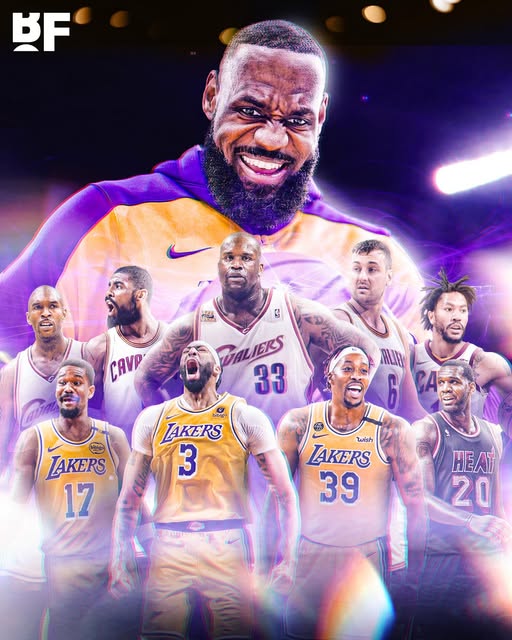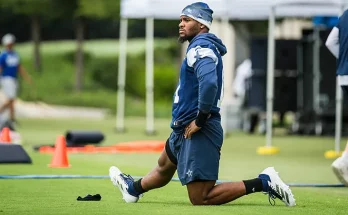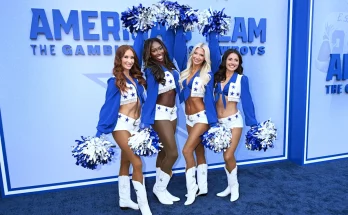In a league built on stars, legacies, and unmatched talent, LeBron James continues to etch his name deeper into the annals of basketball history. Already considered by many as the greatest player the NBA has ever seen, James has broken countless records and set unprecedented benchmarks during his two-decade-long reign. Now, he has added another fascinating accolade to his resume: LeBron James has played alongside more No. 1 overall draft picks than any player in NBA history—nine in total. While it may seem like an obscure statistical note at first glance, this fact offers a compelling glimpse into LeBron’s career, his gravitational pull as a franchise cornerstone, and the ever-evolving landscape of roster construction around him.
The number is striking not just because of its uniqueness, but because of what it says about James’ longevity and the ever-changing cast of elite-level talent that has surrounded him. Drafted first overall in 2003 by the Cleveland Cavaliers, LeBron James entered the league as the most hyped high school player of all time. Since then, he has managed to remain both the league’s central figure and its most coveted teammate. That nine different No. 1 overall picks have suited up alongside him is no coincidence—it is a reflection of his enduring relevance, influence in front-office decisions, and his unmatched ability to draw star power.
LeBron has played with Kyrie Irving, Anthony Davis, Dwight Howard, Derrick Rose, Andrew Wiggins (albeit briefly), Ben Simmons (Team USA-style interactions aside, this was never on a professional roster), Greg Oden (in Miami), Shaquille O’Neal, and now Deandre Ayton in Los Angeles. Each of these players came into the league as the presumed future face of a franchise. Some lived up to the billing, others fell short due to injury or circumstance, but all at some point shared a locker room with James—an emblem of how the game’s past, present, and future all intersect through him.
Take Kyrie Irving, for instance. Drafted No. 1 overall by the Cavaliers in 2011, Irving was viewed as the future of the Cleveland franchise following LeBron’s infamous departure to Miami. The irony is that James would return in 2014, creating one of the most potent duos in recent NBA history. Their chemistry culminated in the 2016 NBA Finals, where they led the Cavaliers to a historic 3–1 comeback against the Golden State Warriors. That championship remains the high point of Cleveland basketball and a defining moment in LeBron’s career. The partnership with Irving showcased how two No. 1 picks—one from the start of a career, another entering his prime—could co-exist, compete, and ultimately conquer.
Then there’s Anthony Davis, another former No. 1 pick who became the centerpiece of James’ next great team. When the Lakers acquired Davis from the New Orleans Pelicans in 2019, it was a seismic shift in the NBA’s power structure. The duo went on to lead Los Angeles to the 2020 NBA championship inside the Orlando bubble. Davis’ elite two-way play perfectly complemented James’ cerebral dominance, and the pairing was proof yet again of LeBron’s unmatched adaptability with top-tier talent.
Dwight Howard and Derrick Rose, both of whom were No. 1 overall selections and MVP-caliber players in their prime, joined James in the twilight of their respective careers. While neither had the same explosive impact alongside LeBron as they did during their individual peaks, their presence on James-led teams was not insignificant. They brought experience, grit, and moments of veteran leadership that helped shape locker room culture. With Howard, James helped secure that 2020 championship as Howard contributed valuable minutes as a rim protector. Rose, though not part of a championship squad with LeBron, served as a valuable mentor and contributor during his time in Cleveland.
One of the more peculiar names on the list is Andrew Wiggins. Drafted No. 1 overall in 2014 by Cleveland, Wiggins was expected to be a running mate for LeBron after the latter announced his return to the Cavaliers. However, Wiggins was traded to Minnesota before the season began in exchange for Kevin Love, a move that prioritized immediate contention over long-term development. Though Wiggins never played a regular season game with James, the transaction links their careers and adds him to this unique historical tally.
Greg Oden, the top pick in the 2007 NBA Draft, represents one of the more unfortunate stories in NBA lore. Injuries robbed him of what could have been a dominant career, but during the 2013–14 season in Miami, Oden shared the floor with James in a brief but symbolic pairing. Even in limited action, Oden’s presence was a reminder of the risks and realities of the draft process and how sometimes the promise of a No. 1 pick doesn’t manifest as planned.
Shaquille O’Neal, one of the most dominant big men in NBA history and the No. 1 pick of the 1992 draft, teamed up with a young LeBron during the 2009–10 season in Cleveland. Though well past his prime, Shaq’s arrival was part of the Cavaliers’ effort to push for a championship before James’ looming free agency. The partnership didn’t produce the desired playoff success, but it was a rare moment where two generational No. 1 picks shared the spotlight, bridging eras in a compelling, if short-lived, alliance.
Now comes Deandre Ayton, recently signed by the Los Angeles Lakers. The former Phoenix Suns big man was the top pick in the 2018 draft and has had an up-and-down career. A strong scorer and rebounder with immense physical tools, Ayton now finds himself with the opportunity to reshape the narrative of his career under the watchful mentorship of LeBron James. If history is any indicator, players who team up with LeBron often find renewed focus, elevated expectations, and a shot at relevance on the biggest stage.
What makes this statistic so fascinating isn’t just the number itself but the timeline it represents. LeBron has managed to stay elite for over 20 years, navigating multiple team builds and playing styles. Through the early Cleveland years, the Miami superteam era, the second Cleveland stint, and now the Los Angeles chapter, James has remained a magnet for elite-level talent. Whether through front-office orchestration or his own gravitational pull, James’ teams often revolve around star-caliber players, and the presence of so many former No. 1 picks underscores how central he has been to the NBA’s evolving narrative.
This milestone also speaks to James’ own No. 1 status—literally and metaphorically. Drafted first overall himself, he has set the gold standard for what a top pick should become. His presence among this group of fellow No. 1s is more than symbolic; it is a testament to the full realization of potential and the continuous pursuit of excellence. He has not only played alongside top picks, but he has often elevated them, influenced their games, and helped redefine their legacies.
Moreover, LeBron’s ability to co-exist with so many uniquely talented No. 1 picks is a testament to his basketball IQ and unselfish nature. He adapts—whether it’s taking a backseat to allow Kyrie to shine in clutch moments, deferring to Davis in the post, or making room for Ayton to rediscover his confidence. James’ presence is not domineering but enabling. He sets the bar high and demands accountability, but also creates a structure in which talent can thrive.
Beyond the numbers and accolades, this record offers yet another chapter in the mythos of LeBron James. In a career that already boasts four NBA championships, four MVP awards, two Olympic gold medals, and the all-time scoring title, the fact that he has now played with more No. 1 picks than anyone in history is both an oddity and a symbol. It captures the story of a player whose career has stretched across generations, touched nearly every corner of the league’s hierarchy, and continued to shape the narratives of players once heralded as future kings themselves.
As the sun gradually begins to set on LeBron’s storied career, his list of records and historical anomalies continues to grow. Playing with nine different No. 1 overall picks is not just a trivia tidbit—it’s a window into the story of modern basketball, one told through the lens of a singular figure whose presence continues to define an era. James is not just part of NBA history; he is NBA history, and this latest milestone is yet another reason why his legacy will endure long after his final game.



